Monthly Archives: December 2019
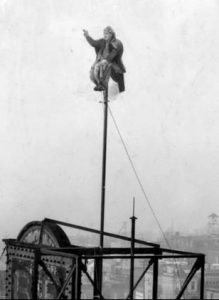 Alvin Kelly was born in Manhattan on May 11, 1893. His story began in a tragic way, because his father died before his birth and his mother died in childbirth with him. Kelly, now a newborn orphan, was raised in orphanages and passed around to various relatives. When Kelly turned 7, he started climbing onto poles and a few years later, he scaled the outside of buildings in his neighborhood…and by the way, his name wasn’t Alvin back then. It was Aloysius Anthony Kelly. He became Alvin when he ran away to go to work on a cargo ship. He was just 13 years old, and he changed his name to Alvin…probably to remain anonymous.
Alvin Kelly was born in Manhattan on May 11, 1893. His story began in a tragic way, because his father died before his birth and his mother died in childbirth with him. Kelly, now a newborn orphan, was raised in orphanages and passed around to various relatives. When Kelly turned 7, he started climbing onto poles and a few years later, he scaled the outside of buildings in his neighborhood…and by the way, his name wasn’t Alvin back then. It was Aloysius Anthony Kelly. He became Alvin when he ran away to go to work on a cargo ship. He was just 13 years old, and he changed his name to Alvin…probably to remain anonymous.
It wasn’t Kelly’s life as a runaway that made him unique, however, because runaways have existed for centuries. His childhood trick of climbing on poles stuck with him for the rest of his life. In fact, during the 1920s and 1930s, Kelly earned a name for himself…and a certain degree of notoriety…by sitting atop flag poles and other odd elevated perches for extended periods of time. I can’t imagine the purpose of such an act, and it’s not the most conventional way to fame, but for Alvin ‘Shipwreck’ Kelly it worked. Shipwreck Kelly, as he became known, is credited with starting the flagpole sitting fad, which, strangely, became popular in the Roaring Twenties, and he even earned a spot in the World Record Book for his sitting ability. I suppose an actor, comedian, magician, and such, needed a gimmick or a nickname, so Kelly began to use the nickname ‘Shipwreck’ claiming that he had survived the sinking of the Titanic. The story was proved to be untrue. Even then, Kelly claimed that he had many other close calls in his life. He said he had survived five shipwrecks, two plane crashes, three car accidents and one train derailment. In reality, Kelly most likely, acquired his nickname in the boxing ring. Not the greatest boxer, critics claimed he was often “adrift and ready to sink.”
As a teen and young man, Kelly hopped from job to job. His unusual ability to climb a pole and perch at the top did earn his work that he might not have otherwise been able to get. In addition to working at sea, he was a stunt pilot, movie double, steelworker, high diver, boxer, and a steeplejack. During World War I, Kelly was an ensign in the Naval Auxiliary Reserve, serving on the USS Edgar F. Luckenbach.
You might be wondering what started his Pole Sitting career. Well, like many a young man, Kelly was not one to back away from a dare. In 1924, he was dared by a friend to climb to the top of a flagpole in Philadelphia  outside a local department store. Of course, Kelly jumped at the chance to prove himself. He quickly ascended the pole and perched himself on top. The stunt attracted a large crowd, many of whom then went inside to shop in the department store. The store manager asked Kelly to stay up there a while…it was good for business! Newspapers carried pictures of Kelly’s stunt, many daredevils began copying his stunt. A fad was born! Soon pole sitting was a popular trick and copycat sitters did it for laughs, on a dare, or to protest. Even though so many others were doing it now, Kelly, the original pole sitter, continued his stunts to the delight of onlookers and journalists. Everyone knew he was the original, and the others were merely copycats.
outside a local department store. Of course, Kelly jumped at the chance to prove himself. He quickly ascended the pole and perched himself on top. The stunt attracted a large crowd, many of whom then went inside to shop in the department store. The store manager asked Kelly to stay up there a while…it was good for business! Newspapers carried pictures of Kelly’s stunt, many daredevils began copying his stunt. A fad was born! Soon pole sitting was a popular trick and copycat sitters did it for laughs, on a dare, or to protest. Even though so many others were doing it now, Kelly, the original pole sitter, continued his stunts to the delight of onlookers and journalists. Everyone knew he was the original, and the others were merely copycats.
Never content, Kelly continued to look for ways to outdo his latest tricks. In 1926 in Saint Louis, he stayed perched atop a pole for seven days and one hour. The next year, in June of 1927 in Newark, New Jersey, he extended his record to twelve days. Next, it was a 23 day sit on a flagpole in Carlin’s Park in Baltimore in 1929. His final record was set in 1930 when he stayed on a flagpole on Atlantic City’s Steel Pier for 49 days and one hour. I don’t know about you, but I can’t begin to imagine such extended days sitting on a flagpole. Nevertheless, for Kelly, it seemed to be a normal part of his daily routine. Newspapers of the 1920s loved to feature photographs of Kelly “sitting high in the air, especially ones of him doing everyday things, like shaving or reading a newspaper or brushing his teeth. During his sits, Kelly rarely ate, sustaining himself on coffee and cigarettes. Although he used a leg tether as a safeguard against falling, He learned to sleep sitting upright and he explained that he slept with his thumbs stuck in holes in the pole. If he started to lean one way or the other in his sleep, the pain in his thumbs would wake him in time for him to right himself.”
Kelly toured across the country during the peak of his fame, and charged admission for people to see him sitting on a flagpole. I would find watching someone sit on a pole would be boring, but people did. He once estimated that he spent 20,613 hours sitting on flag poles in his lifetime, including about 1,400 hours in 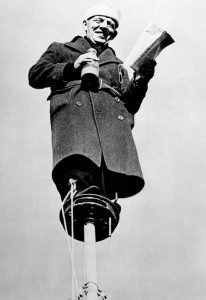 pouring down rain and 210 hours in sub-freezing temperatures. He was often hired to do publicity stunts because business owners knew he could draw a crowd. For example, on October 13, 1939, Kelly was hired to promote National Donut Dunking Week by sitting on a pole in Manhattan and eating 13 donuts dipped in coffee. I wonder how much they paid him for that stunt.
pouring down rain and 210 hours in sub-freezing temperatures. He was often hired to do publicity stunts because business owners knew he could draw a crowd. For example, on October 13, 1939, Kelly was hired to promote National Donut Dunking Week by sitting on a pole in Manhattan and eating 13 donuts dipped in coffee. I wonder how much they paid him for that stunt.
As the Great Depression of the 1930s progressed, people became less interested in Kelly’s tricks…and less tolerant. In 1935, he attempted to break his own record again, but the Bronx police said he was creating a public nuisance. The police threatened to chop down his pole, if he didn’t come down and when he did, he was promptly arrested. His last attempt at pole sitting was in Orange, Texas, in 1952. That day, while sitting on the pole, Kelly suffered two heart attacks and was forced to come down. He announced his retirement from pole sitting and died a week later.
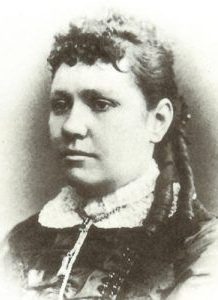 Alice Ivers Tubbs was born in Devonshire, England on February 17, 1851. She was the daughter of a conservative schoolmaster. While Alice was still a small girl, she moved with her family to the United States. The family first settled in Virginia, where Alice attended an elite boarding school for women. When she was a teenager, the family moved with the silver rush to Leadville, Colorado. As a young girl, Alice was raised to be a well-bred young lady, so few people would ever expect her to be known as “Poker Alice.” Nevertheless, marriage can change a person. While living in Leadville, Alice met a mining engineer named Frank Duffield, whom she married when she was just 20 years old. In the mining camps, gambling’s was quite common, and Frank was an enthusiastic player. He enjoyed visiting the gambling halls in Leadville and Alice naturally went along with him, rather than staying home alone. Alice stood quietly and watch her husband play…at first, but Alice was smart, and she picked up the game of poker easily. Soon she was sitting in on the games, and she was winning. Alice’s marriage to Frank Duffield was short-lived. Duffield, who worked in the mines as part of his job, was killed in an explosion. Needing to make a living, Alice, who was well educated, could have taught school, but even with 35,000 residents in Leadville, there was no school. There were also few jobs available for women, and those there were, did not appeal to Alice, so she decided to make a living gambling. Though Alice preferred the game of poker, she also learned to deal and play Faro. Very soon, she was in high demand…as a player and a dealer. Alice was a petite 5 foot 4 inch beauty, with blue eyes and thick brown hair. She was very rare in that she was a “lady” in a gambling hall…and not of the “soiled dove” variety. And Alice loved the latest fashions, she was a sight for the sore eyes of many a miner. Every time Alice had a big win, she began to take trips to New York City to buy the latest fashions.
Alice Ivers Tubbs was born in Devonshire, England on February 17, 1851. She was the daughter of a conservative schoolmaster. While Alice was still a small girl, she moved with her family to the United States. The family first settled in Virginia, where Alice attended an elite boarding school for women. When she was a teenager, the family moved with the silver rush to Leadville, Colorado. As a young girl, Alice was raised to be a well-bred young lady, so few people would ever expect her to be known as “Poker Alice.” Nevertheless, marriage can change a person. While living in Leadville, Alice met a mining engineer named Frank Duffield, whom she married when she was just 20 years old. In the mining camps, gambling’s was quite common, and Frank was an enthusiastic player. He enjoyed visiting the gambling halls in Leadville and Alice naturally went along with him, rather than staying home alone. Alice stood quietly and watch her husband play…at first, but Alice was smart, and she picked up the game of poker easily. Soon she was sitting in on the games, and she was winning. Alice’s marriage to Frank Duffield was short-lived. Duffield, who worked in the mines as part of his job, was killed in an explosion. Needing to make a living, Alice, who was well educated, could have taught school, but even with 35,000 residents in Leadville, there was no school. There were also few jobs available for women, and those there were, did not appeal to Alice, so she decided to make a living gambling. Though Alice preferred the game of poker, she also learned to deal and play Faro. Very soon, she was in high demand…as a player and a dealer. Alice was a petite 5 foot 4 inch beauty, with blue eyes and thick brown hair. She was very rare in that she was a “lady” in a gambling hall…and not of the “soiled dove” variety. And Alice loved the latest fashions, she was a sight for the sore eyes of many a miner. Every time Alice had a big win, she began to take trips to New York City to buy the latest fashions.
Due to her traveling from one mining camp to another to play poker, Alice soon acquired the nickname “Poker Alice.” In addition to playing the game, she often worked as a dealer, in cities all over Colorado including Alamosa, Central City, Georgetown, and Trinidad. Later on, Alice began to puff on large black cigars, still wearing her fashionable frilly dresses. She, nevertheless, never gambled on Sundays because of her religious beliefs. Alice carried a .38 revolver and wasn’t afraid to use it. It was rather a necessity, due to her lifestyle. Alice soon left Colorado and made her way to Silver City, New Mexico, where she broke the bank at the Gold Dust Gambling House, winning some $6,000. The win was followed by a trip to New York City, to replenish her wardrobe of fashionable clothing. Afterward, she returned to Creede, Colorado. She went to work as a dealer in Bob Ford’s saloon…the man who had earlier killed Jesse James. Alice later moved to Deadwood, South Dakota around 1890. In Deadwood, she met a man named Warren G. Tubbs, who worked as a housepainter in Sturgis, but sidelined as a dealer and 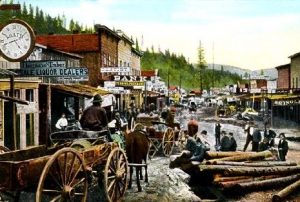 gambler. Alice usually beat Tubbs at poker, but that didn’t bother him. He was taken with her and they began to see each other socially. Once a drunken miner threatened Tubbs with a knife, Alice pulled out her .38 and put a bullet into the miner’s arm. I’m sure that man thought the threat was Tubbs, but the man should have watched Alice in stead. Later, the couple married and had seven children…four sons and three daughters. Because Tubbs was a painter by trade, he, along with Alice’s gambling profits, supported the family. The family moved out of Deadwood, to homesteaded a ranch near Sturgis on the Moreau River. Finally, Alice found something she loved more than gambling…for the most part. She helped with the ranch and raised her children. Then, fate would again deal Alice a bad hand. Tubbs was diagnosed with tuberculosis. Alice refused to leave his side. She planned to nurse him back to health. Tubbs lost his fight, and died of pneumonia in the winter of 1910. Alice was determined to give him a proper burial, so she loaded him into a horse-drawn wagon to take his body to Sturgis. It is thought that she had to pawn her wedding ring to pay for the funeral and afterward, went to a gambling parlor to earn the money to get her ring back.
gambler. Alice usually beat Tubbs at poker, but that didn’t bother him. He was taken with her and they began to see each other socially. Once a drunken miner threatened Tubbs with a knife, Alice pulled out her .38 and put a bullet into the miner’s arm. I’m sure that man thought the threat was Tubbs, but the man should have watched Alice in stead. Later, the couple married and had seven children…four sons and three daughters. Because Tubbs was a painter by trade, he, along with Alice’s gambling profits, supported the family. The family moved out of Deadwood, to homesteaded a ranch near Sturgis on the Moreau River. Finally, Alice found something she loved more than gambling…for the most part. She helped with the ranch and raised her children. Then, fate would again deal Alice a bad hand. Tubbs was diagnosed with tuberculosis. Alice refused to leave his side. She planned to nurse him back to health. Tubbs lost his fight, and died of pneumonia in the winter of 1910. Alice was determined to give him a proper burial, so she loaded him into a horse-drawn wagon to take his body to Sturgis. It is thought that she had to pawn her wedding ring to pay for the funeral and afterward, went to a gambling parlor to earn the money to get her ring back.
For Alice, the time spent on the ranch were some of the happiest days of her life and that during those years, she didn’t miss the saloons and gambling halls. Alice liked the peace and quiet of the ranch. Still, she had to make a living, so after Tubbs’ death, she hired a man named George Huckert to take care of the homestead, and she moved to Sturgis to earn her way. Huckert quickly fell in love with Alice and proposed marriage to her several times. Alice didn’t really love him, but finally married him, saying flippantly, “I owed him so much in back wages; I figured it would be cheaper to marry him than pay him off. So I did.” Once again, the marriage would be short. Alice was widowed once again when Huckert died in 1913.
During the Prohibition years, Alice opened a saloon called “Poker’s Palace” between Sturgis and Fort Meade that provided not only gambling and liquor, but also “women” who serviced the customers. One night, a drunken soldier began a fight in the saloon. He was destroying the furniture, and causing a ruckus. Alice pulled her .38 and shot the man. While in jail awaiting trial, she calmly smoked cigars and read the Bible. She was acquitted on grounds of self-defense, but her saloon had been shut down. Now, in her 70s and with her beauty and fashionable gowns long gone, Alice struggled in her last years. She continued to gamble, but these days, she dressed in men’s clothing. Once in a while, she was featured at 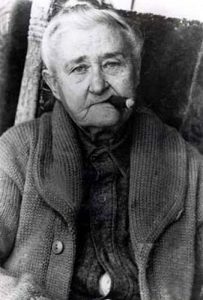 events like the Diamond Jubilee, in Omaha, Nebraska, as a true frontier character, where she was known to have said, “At my age, I suppose I should be knitting. But I would rather play poker with five or six ‘experts’ than eat.” She continued to run a “house” of ill-repute in Sturgis during her later years and was often arrested for drunkenness and keeping a disorderly house. Though she paid her fines, she continued to operate the business until she was finally arrested for repeated convictions of running a brothel and sentenced to prison. The governor took pity on Alice, who was then 75 years old, and pardoned her. At the age of 79, Alice underwent a gall bladder operation in Rapid City. Unfortunately, she died of complications on February 27, 1930. She was buried at Saint Aloysius Cemetery in Sturgis, South Dakota. In her lifetime, Alice claimed to have “won more than $250,000 at the gaming tables and never once cheated.” In fact, one of her favorite sayings was, “Praise the Lord and place your bets. I’ll take your money with no regrets.”
events like the Diamond Jubilee, in Omaha, Nebraska, as a true frontier character, where she was known to have said, “At my age, I suppose I should be knitting. But I would rather play poker with five or six ‘experts’ than eat.” She continued to run a “house” of ill-repute in Sturgis during her later years and was often arrested for drunkenness and keeping a disorderly house. Though she paid her fines, she continued to operate the business until she was finally arrested for repeated convictions of running a brothel and sentenced to prison. The governor took pity on Alice, who was then 75 years old, and pardoned her. At the age of 79, Alice underwent a gall bladder operation in Rapid City. Unfortunately, she died of complications on February 27, 1930. She was buried at Saint Aloysius Cemetery in Sturgis, South Dakota. In her lifetime, Alice claimed to have “won more than $250,000 at the gaming tables and never once cheated.” In fact, one of her favorite sayings was, “Praise the Lord and place your bets. I’ll take your money with no regrets.”
 When people think of Venice, Italy, they think of the canals and the boats. I think most of us think the city is pretty much streets of water, and buildings that somehow stand in the water…strong and immovable against the water. Venice is the center of the lagoon of Venice, which extends over a length of 25 miles around the city. While it seems like the city is covered in water, only 11% of the lagoon is permanently covered with water, while the rest of the lagoon is islands or mudflats and marshes (Laguna Morta). The water stays fresh because, seawater from the Adriatic flows into the lagoon through three large passages, Bocca di Lido, Bocca di Malamocco, and Bocca di Chioggia, twice daily. This process provides a natural water exchange. Still, 11% water can sure look like a lot, especially when every touristy picture we see involves the canals and gondolas. So, to think of a situation whereby a flood could become tragic in Venice, is a strange thought for anyone who doesn’t really know Venice…like me.
When people think of Venice, Italy, they think of the canals and the boats. I think most of us think the city is pretty much streets of water, and buildings that somehow stand in the water…strong and immovable against the water. Venice is the center of the lagoon of Venice, which extends over a length of 25 miles around the city. While it seems like the city is covered in water, only 11% of the lagoon is permanently covered with water, while the rest of the lagoon is islands or mudflats and marshes (Laguna Morta). The water stays fresh because, seawater from the Adriatic flows into the lagoon through three large passages, Bocca di Lido, Bocca di Malamocco, and Bocca di Chioggia, twice daily. This process provides a natural water exchange. Still, 11% water can sure look like a lot, especially when every touristy picture we see involves the canals and gondolas. So, to think of a situation whereby a flood could become tragic in Venice, is a strange thought for anyone who doesn’t really know Venice…like me.

On December 1, 2008, Venice experienced the biggest flood in more than twenty years. The waters rose more than five feet above normal levels. As with any flood, many of Venice’s streets, including Saint Mark’s Square, were submerged. Venice has flooding for about two hundred days every year, and the Venetian authorities were working to complete an underwater dam by 2011. Unfortunately, that fact didn’t help the city in 2008. Even with unusually high tides because of the new moon, residents were not surprised to see the usual low-lying lanes under water. Nevertheless, this day was different. Pretty much the entire city was covered by the lagoon. People stayed inside to wait out the water, only going outside when they were sure the water was definitely going down. The townspeople went outside to take pictures and explore the current townscape…to see what was underwater now. They were quite surprised at the scene before them.
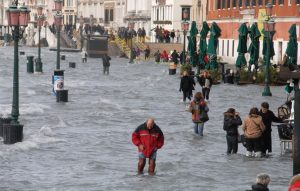
By mid-afternoon, the water had gone down to more normal levels, but all over the world, the papers made it seem like the whole city was sinking. The high tide would come again on December 2nd, but it was nothing like December 1st. Cleanup was still underway on December 2nd, of course, but most businesses were open again. I suppose that if your city spends it’s life in one stage of flood or another, this extra high tide was just something to be taken in stride. Yes, people were surprised at the higher than normal flood waters from the tide, but they weren’t panicked. It was just another day in the life of Venice.

